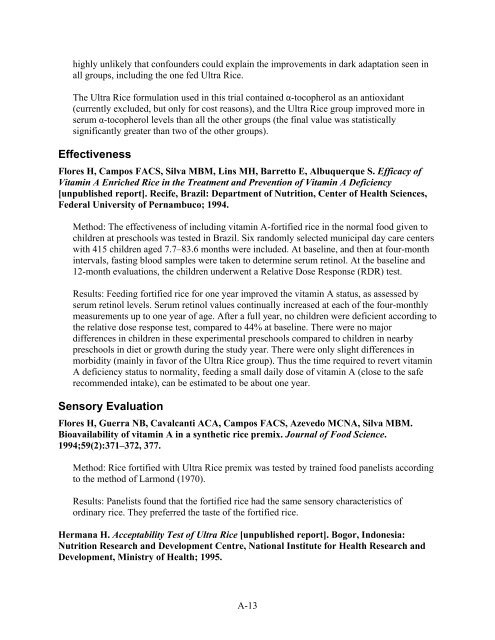The Research Behind the Ultra Rice® Technology - Path
The Research Behind the Ultra Rice® Technology - Path
The Research Behind the Ultra Rice® Technology - Path
You also want an ePaper? Increase the reach of your titles
YUMPU automatically turns print PDFs into web optimized ePapers that Google loves.
highly unlikely that confounders could explain <strong>the</strong> improvements in dark adaptation seen in<br />
all groups, including <strong>the</strong> one fed <strong>Ultra</strong> Rice.<br />
<strong>The</strong> <strong>Ultra</strong> Rice formulation used in this trial contained -tocopherol as an antioxidant<br />
(currently excluded, but only for cost reasons), and <strong>the</strong> <strong>Ultra</strong> Rice group improved more in<br />
serum -tocopherol levels than all <strong>the</strong> o<strong>the</strong>r groups (<strong>the</strong> final value was statistically<br />
significantly greater than two of <strong>the</strong> o<strong>the</strong>r groups).<br />
Effectiveness<br />
Flores H, Campos FACS, Silva MBM, Lins MH, Barretto E, Albuquerque S. Efficacy of<br />
Vitamin A Enriched Rice in <strong>the</strong> Treatment and Prevention of Vitamin A Deficiency<br />
[unpublished report]. Recife, Brazil: Department of Nutrition, Center of Health Sciences,<br />
Federal University of Pernambuco; 1994.<br />
Method: <strong>The</strong> effectiveness of including vitamin A-fortified rice in <strong>the</strong> normal food given to<br />
children at preschools was tested in Brazil. Six randomly selected municipal day care centers<br />
with 415 children aged 7.7–83.6 months were included. At baseline, and <strong>the</strong>n at four-month<br />
intervals, fasting blood samples were taken to determine serum retinol. At <strong>the</strong> baseline and<br />
12-month evaluations, <strong>the</strong> children underwent a Relative Dose Response (RDR) test.<br />
Results: Feeding fortified rice for one year improved <strong>the</strong> vitamin A status, as assessed by<br />
serum retinol levels. Serum retinol values continually increased at each of <strong>the</strong> four-monthly<br />
measurements up to one year of age. After a full year, no children were deficient according to<br />
<strong>the</strong> relative dose response test, compared to 44% at baseline. <strong>The</strong>re were no major<br />
differences in children in <strong>the</strong>se experimental preschools compared to children in nearby<br />
preschools in diet or growth during <strong>the</strong> study year. <strong>The</strong>re were only slight differences in<br />
morbidity (mainly in favor of <strong>the</strong> <strong>Ultra</strong> Rice group). Thus <strong>the</strong> time required to revert vitamin<br />
A deficiency status to normality, feeding a small daily dose of vitamin A (close to <strong>the</strong> safe<br />
recommended intake), can be estimated to be about one year.<br />
Sensory Evaluation<br />
Flores H, Guerra NB, Cavalcanti ACA, Campos FACS, Azevedo MCNA, Silva MBM.<br />
Bioavailability of vitamin A in a syn<strong>the</strong>tic rice premix. Journal of Food Science.<br />
1994;59(2):371–372, 377.<br />
Method: Rice fortified with <strong>Ultra</strong> Rice premix was tested by trained food panelists according<br />
to <strong>the</strong> method of Larmond (1970).<br />
Results: Panelists found that <strong>the</strong> fortified rice had <strong>the</strong> same sensory characteristics of<br />
ordinary rice. <strong>The</strong>y preferred <strong>the</strong> taste of <strong>the</strong> fortified rice.<br />
Hermana H. Acceptability Test of <strong>Ultra</strong> Rice [unpublished report]. Bogor, Indonesia:<br />
Nutrition <strong>Research</strong> and Development Centre, National Institute for Health <strong>Research</strong> and<br />
Development, Ministry of Health; 1995.<br />
A-13
















